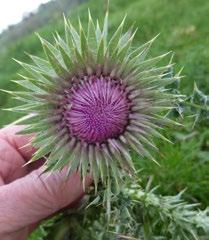
11 minute read
europaea (Cornish Moneywort), Breconshire (v.c.42). John Crellin (see Wales roundup
WALES
According to the summary of New Year Plant Hunts (NYPH) throughout Britain and Ireland, 132 lists were submitted from Wales, a significant increase on past years. Most species recorded were ‘autumn stragglers’ rather than winter or early flowerers and the majority were native species; not surprising as most records were from rural habitats. Perhaps the best find should go to Sue and Steve Southam in Montgomeryshire (v.c. 47) who recorded 31 species including a splendid Carduus nutans (Musk Thistle).
Advertisement
Carduus nutans (Musk Thistle), Montgomeryshire (v.c. 47). Sue Southam
The pick of the non-natives in flower was Lagurus ovatus (Hare’stail), a new vice-county record for Cardiganshire (v.c. 46) found by Andy Jones. Andy mentions that a beneficial side-effect of the NYPH was having the time to look more closely at a few flowering taxa, including the hybrid between Ulex europaeus (European Gorse) and U. gallii (Western Gorse) (U. × breoganii), which appears to be far more widespread than previously noticed and may well be overlooked for the NYPH in other south-western counties.
David Barden, Joint VCR for East Glamorgan (v.c. 41), has published a detailed Flora of a relatively compact but remarkably diverse area of rhôs pasture. The Wild Plants of Llantrisant Common and Y Gweira covers the 400+ taxa found during his nine-year survey of the site, and includes distribution maps and quadrat studies, as well as plenty of photos, identification tips and historical context to make it appeal to a wide audience (see review, p. 76).
In Breconshire (v.c. 42), John Crellin and the local botany group visited their only Sibthorpia europaea (Cornish Moneywort) site late in 2020, finding an abundance of the plant all along the stream it grows by, having survived the installation of a nearby hydro scheme. The site was first found in 2000 by Steve Chambers and others, prior to the installation of a gas pipeline across the headwaters, ruling that activity out as a vector for introduction.
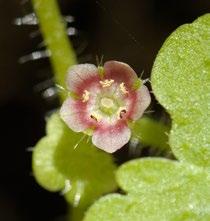
Sibthorpia europaea (Cornish Moneywort), Breconshire (v.c. 42). John Crellin
A new edition of the Breconshire County Rare Plant Register has been completed and a few copies printed, thanks to the generosity of the Brecon Beacons National Park Authority. This edition has a cut-off date of 2000 and was intended to match the Atlas data – but 2021 had to be included after finding so many good things! John has also submitted a long list of altitude records to David Pearman, many of which beat the previous known limit for a species. These are very useful for many purposes, not least the forthcoming Atlas, which will include information on this subject.
In Pembrokeshire (v.c. 45), Stephen Evans has been typically busy, and made a visit to the Conwy valley in North Wales to see and collect cuttings from the captive Pembrokeshire Juniperus communis (Juniper) stocks which are kindly maintained, along with material from other Welsh junipers, by the owners of the nursery. This effort is a revival of the previous attempts to bolster the handful of relict male and female bushes on Ramsey Island. Unfortunately, Covid-19 prevented the usual annual surveys of Platanthera bifolia (Lesser Butterfly-orchid) and Melittis melissophyllum (Bastard Balm) populations in the county that have been undertaken in June for more than 20 years. However, grocery shopping proved productive, with some work on M. melissophyllum undertaken en route to the store, as well as checks on the only Welsh plant of Sea Pea Lathyrus japonicus on the sandy shingle at Ceibwr. Later in the summer, when restrictions were lifted (temporarily, as it turned out), the 21st annual count of Shore Dock Rumex rupestris at Marloes revealed some surprises. There had been a massive winter cliff slump at the Hooper’s Point end confirming that the upper beach was definitely no longer suitable for the plant. Moreover, the surviving population at Watery Bay could not be recorded owing
to another cliff collapse that had blocked the tricky beach access via a cave complex. The species could, however, be spotted from the cliff top so its survival into 2020 was confirmed.
Stephen also visited the Asparagus prostratus (Wild Asparagus) colonies on the army range at Penally, and was encouraged to find berries on one of the female plants. Twenty-five berries were pushed into the sandy cliff top turf; berries had last been found in 2004 when some were similarly pressed into the ground. Two tiny plants germinated from this in situ ‘planting’; one has survived and its growth has been followed each year.
Matt Sutton contributed a number of excellent records for the county, including the exciting find of Hymenophyllum tunbrigense (Tunbridge Filmyfern) from block scree on the NW-facing slopes of 120 m high cliffs at Pwll Deri whilst recording bryophytes in late October. It is the first discovery of this fern on the extensive sea-cliffs of Pembrokeshire. Matt also found Dryopteris expansa (Northern Buckler-fern) new to the county on the edge of block scree on the same cliff. Finally, Stephen mentions that one of the redeeming experiences during lockdown in 2020 was being able to enjoy the splendour of Dactylorhiza praetermissa/ purpurella (Marsh Orchids) stands on one of their three wet fields. Over 3,600 purple flowering spikes were counted in June, the numbers increasing each year from just a single spike found in 2011!
Following the letter sent to the Kenfig Corporation Trust from SJT and Lynne Farrell, although we had no response, Julian Woodman reports that NRW has entered into a management agreement with the Corporation Trust, a little like the Section 16 agreements for SSSIs, and that a new Kenfig warden has been appointed.
Steph Tyler
SCOTLAND
The level of recording activity in 2020 was, understandably, lower than in previous years. However, any comparison between 2020 and 2019 was always going to be distorted by the frenzy of recording in 2019 associated with Atlas 2020. A snapshot comparison with a more ‘normal’ year shows that, while the geographical range of recording in Scotland was much less in 2020 than in 2019, the species diversity recorded was still relatively rich, and compared with the 2019, a higher proportion of monads visited in 2020 were recorded in depth (more than 250 records/ monad).
Far from being a year only of negatives, 2020 – for all its restrictions – offered some real positives. For instance, a common theme among Scottish vice-county Annual Reports has been the precious opportunity for personal study and in-depth fieldwork in a small, local area afforded by all the restrictions on meeting and travelling. This was particularly true in urban areas: people took time to look more closely than usual at their local flora, and in many places the absence of weed control by councils allowed all sorts of botanical wonders to spring up!
Street weeds were a particular focus in Edinburgh. In St Andrews, Sandy Edwards conducted a study of pavement weeds and found a lot more Mycelis muralis (Wall Lettuce) than usual (this was also noticed by recorders in Fort William) and a notable increase in Conyza canadensis (Canadian Fleabane). In Dundee, Brian Ballinger looked at sections of 50 walls, as well as repeating a 2001 study of 25 local streets. And in Glasgow, two newlyfound aliens, both expected to increase, were first vice-county records for Lanarkshire: Lactuca
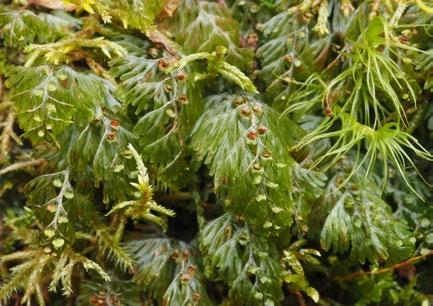
Hymenophyllum tunbrigense (Tunbridge Filmy-fern) (taken on Colonsay, 2018). Pete Stroh
virosa (Great Lettuce), until now only recorded from the east of Scotland, and Picris hieracioides subsp. hieracioides (Hawkweed Oxtongue). Another positive experience for many people was the diversity they recorded by visiting the same location(s) several times in a season, in contrast to the more familiar ‘one hit wonder’ approach of field outings. It makes one realise just how much is routinely missed: a single visit might only yield 60–70% of a site’s actual species total. In addition to fieldwork, lockdown provided the perfect excuse for some scholarship and admin work. In Orkney (v.c. 111), John Crossley has taken time to draft academic material on Tripleurospermum (Mayweed) hybrids and the occurrence of glands in Dryopteris (Bucklerferns), and to put together comprehensive data on native Betula pubescens (Downy Birch) on the island of Hoy. In many vice-counties, significant time was spent on data validation.
Rare Plant Registers are being written for Kincardineshire (v.c. 91) and for Wigtownshire (v.c. 74) – where the new Recorder, Michael Jeeves, has hit the ground running – and existing Rare Plant Registers have been updated in three other vice-counties. Two county Floras have been updated and three brand new Floras are in preparation: for Selkirkshire (v.c. 79), Roxburghshire (v.c. 80) and Moray (v.c. 95).
Readers are directed to the vice-county reports, available in the 2021 Scottish Newsletter (bsbi. org/scottish-newsletter), for a full account of the year’s activity and the most significant finds. There is space here to mention just a few random examples – to showcase the sheer variety of places Scottish botanists got to in the lockdown year, and something of what they found there…
The cliffs at Tantallon Castle, East Lothian – Scabiosa columbaria (Small Scabious). Mud exposed by low water levels at the western end of Loch Venacher, near Callander – Alopecurus aequalis (Orange Foxtail), Helosciadium inundatum (Lesser Marshwort), Eleogiton fluitans (Floating Club-rush) and Lythrum portula (Water-purslane). Neave Island, off the very north coast of Scotland near Bettyhill – the unusual pairing of Salix herbacea (Dwarf Willow) and Scilla verna (Spring Squill). Rarely-visited mountain corries on the north of the Aonach Eagach, Glencoe – Lycopodium annotinum (Interrupted Clubmoss). The railway carpark at Stonehaven – Hieracium sabaudum f. bladonii (a Hawkweed). The ferry port at Stromness, Orkney – Cochlearia danica (Danish Scurvy-grass) as a new vice-county record. The west coast of Lewis, Outer Hebrides – Tripolium pannonicum var. condensatus (Sea Aster). Waterside Bing, East Ayrshire – second ever record of Anacamptis pyramidalis (Pyramidal Orchid) in the county. The Ben Alder hills, Invernessshire (coincidentally visited by several different botanists!) resulting in a tremendous haul of detailed arctic-alpine records. An access road in Cloich Forest, Peeblesshire – Logfia minima (Small Cudweed). The area around Kirkcudbright – 15 Rubus (Bramble) species on a Bramble Workshop. Seaside crags at Strathsteven, between Brora and Golspie, Sutherland – Asplenium marinum (Sea Spleenwort) for the first time in 123 years. The car park at Aviemore station, Invernessshire – Linaria × dominii (Purple Toadflax × Pale Toadflax hybrid). Arable areas in South Mainland,
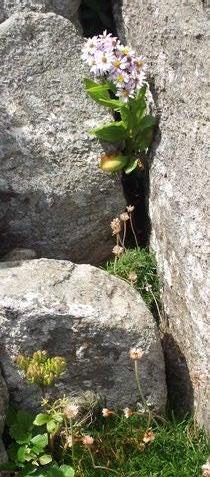
Aster tripolium var. condensatus (Sea Aster) with Ligusticum scoticum (Scots Lovage), near Dalbeg, Isle of Lewis, August 2020. Paul Smith
Shetland – Silene gallica (Smallflowered Catchfly), a second vice-county record. A neglected brown-field site near Kirkintilloch – a huge population of Hypopitys monotropa (Yellow Bird’s-nest). The island of Eigg – Solanum nigrum (Black Nightshade) as a new vice-county record.
Here’s to a return to widespread group fieldwork sometime soon. Hopefully, reading this has put you in mind to travel to far-flung places and enjoy the wonders of field botany in Scotland!
Michael Philip
Vice-county Recorder for Lanarkshire (v.c. 77)
botany@opus44.co.uk
IRELAND
The year started off with the New Year Plant Hunt, and again there was a good turnout from Ireland, with 98 lists submitted. The highest number of plants in flower on a single list was 72, and in all 2,178 individual records were made.
Various restrictions have meant that there are not many botanical finds to report. However, Ciarán Byrne discovered a fifth site for Equisetum hyemale (Rough Horsetail) in a wood on the bank of the Arrigle River, a tributary of the River Nore, at Pleberstown in February of this year. It is a new hectad record in Co. Kilkenny (v.c. H11). And staying in the county, I have recently been told that Fumaria densiflora (Dense-flowered Fumitory) was found as a weed in the corner of a commercial onion field at Sheaston by Roger Goodwillie last year. This is the only Irish record south of Co. Dublin (v.c. H21), and only the third Irish record post 2000, as prior to this there are no records after 1962.
In Co. Louth (v.c. H31), Edna and Ciarán Flynn found Vaccinium vitis-idaea (Cowberry) in February at a new site in the Cooley Mountains on Clermont Cairn, which is both a new hectad record and only the third hectad in which the species has been recorded from in the county.
There is a new vice-county recorder in place for W. Mayo (v.c. H27), Eoin McGreal. He takes over from Gerry Sharkey, who retired from the post last year. Eoin has already been busy and has set up a joint county page on the BSBI website for both the Mayo vice-counties, with Eamonn Delaney the Vice-county Recorder for E. Mayo (H26). There are also new county pages for Co. Clare (v.c. H9), Co. Louth, and for the three Vice-counties that make up Co. Cork (v.cc. H3–5).
By the time you read this report the Irish Spring Conference will have taken place. There were ten presentations on the day, all of which can be viewed by visiting the BSBI Irish Conference webpage.
Paul Green
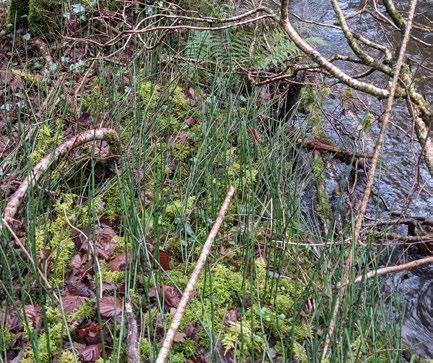
Equisetum hyemale (Rough Horsetail), Pleberstown, Co. Kilkenny (v.c. H11), February 2021. Ciarán Byrne
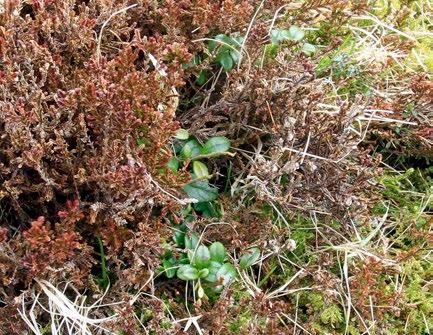
Vaccinium vitis-idaea (Cowberry), Clermont Cairn, Co. Louth (v.c. H31), February 2021. Edna Flynn









